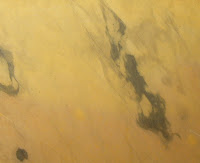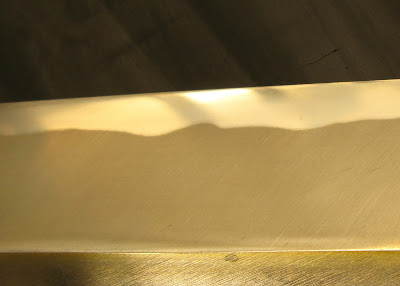This is another stone I bought at a dutch auction from 330mate.com. When I got the stone I was amazed over the clean board and very nice colors. It was basically a kiita coloured stone with pink and green shades, but more visible was the very nice karasu breaking through. My first sharpening session, however, was a mixed experience.
The response from the stone was beautiful. Very efficient as the karasu in the stone pulled metal filings from the first pass and in addition it did not take more than 25-30 passes before I had built a nice thick creamy slurry. The down side being that the underside of the stone was not level, making the stone rock around.
I took the stone to my workshop to try to chisel of the unevenness by removing the rest of a layer that was about to part from the stone anyways. After this large flat chip was removed, I discovered a beautiful, dense and dark silvery grey karasu board underneith. I threw all sensibility overboard and with my coarse diamond plate, I ground away the rest of the very nice skin on the underside of the stone revealing a full board of dense, uniform karasu. I was just staring in awe for a moment at that absolutely beautiful karasu appearing from under the skin.
As the karasu was so dense and dark, I expected it to be quite scratchy and coarse, so I took one of my lesser knives to test it out. I did not at all expect what happened next. The darker side was significantly coarser than the top "kiita" side of the stone, as I suspected, but it was not at all scratchy. Not one bit! It felt a little bit like a very nice and uniform Asagi only even more aggressive. In the back of my head I could almost hear Darth Vader thunder "Come over to the dark side, Darkhoek. Feel the force!" :o)
As you can see from the pictures, there are some white lines on the dark side. These lines are softer than the rest, probably contributing positively to the very nice slurry building on the dark side as well. The lighter shades mixed in with the carasu I suspected to be trases of skin or rust at first, but it is actually the kiita side breaking through to the dark side, helping to refine the slurry and making this stone a perfect blend.
The dark side pulls metal from the first pass with just water on the board. No wonder, considering the density of the mica making out the karasu. However, the stone gives up a very nice, dense slurry after only a few passes, making it very enjoyable and delicate to use, and as I mentioned earlier, totally free from renegade scratchy particles. After some work, the particles seem to break down to a very fine grit, making the slurry almost as fine as the slurry of the top side.
Judging from the scratch pattern I would grade the dark side of the stone very close to my Ozuku Asagi at #6-8000 grit, and as you can see the scratch pattern is very uniform and fine with few visible lines. This patteren is achieved using the slurry, which shows a pattern a lot finer than the #6-8000 and closer to the top side comparing the scratch patterns from both sides of the stone. Sample is 20mm across.
The lighter side is more of a finisher. It is exeptionally uniform and clean, and the karasu makes for a very efficient stone. The light side also gives up a dense creamy slurry quite quickly, even more slick and delicate than the dark side.
Scratch pattern shows a very uniform and fine grit perfect for most kitchen knives exept the most demanding sashimi slicers, which requires my finest Ohira suita or Nakayama. You can see the difference mainly in the lamination line between the Ji and Ha, where the top side shows almost no scratch marks at all. Apart from that the two sides are a lot alike using the slurry effectively. Sample is 20mm across.
The reflection pattern shows an apparently highly polished edge with a clear contrast between Ji and Ha. This polished look is actually due to the very fine scratch pattern from the natural stone. Looking at the picture above the surface is actually matte to the look. This highly complex scratch pattern I believe is one of the main factors to get the edge really sharp and more wear resistant than an edge polished to a full mirror finish by fine synthetic abrasives. You can find some very good reading about this theory here http://thejapanblade.com/sharpvsshiny.htm
Seen from the side, the stone shows a very even transition from the light board on top to the full dense karasu side on the bottom. This will probably result in the top side gradually showing more karasu over time and the dark side to gradually lighten up until there is no more stone left. As I intend to use this stone carefully and wisely, I am sure it will give me many years of enjoyment.
Summing up, I can't really believe my luck with this stone. It is really two very good stones in one, and a perfect stone to carry for travel, as it can erase micro chips easily with the dark side, and refine the edge to a razor sharp using the light side. I have not really seen anything like this stone before, and I could only whish it was full size, but then I could probably never afford it. Darth Vaders words to his son Luke have never been more true: "The force of the Dark side is strong, Luke!"


















































